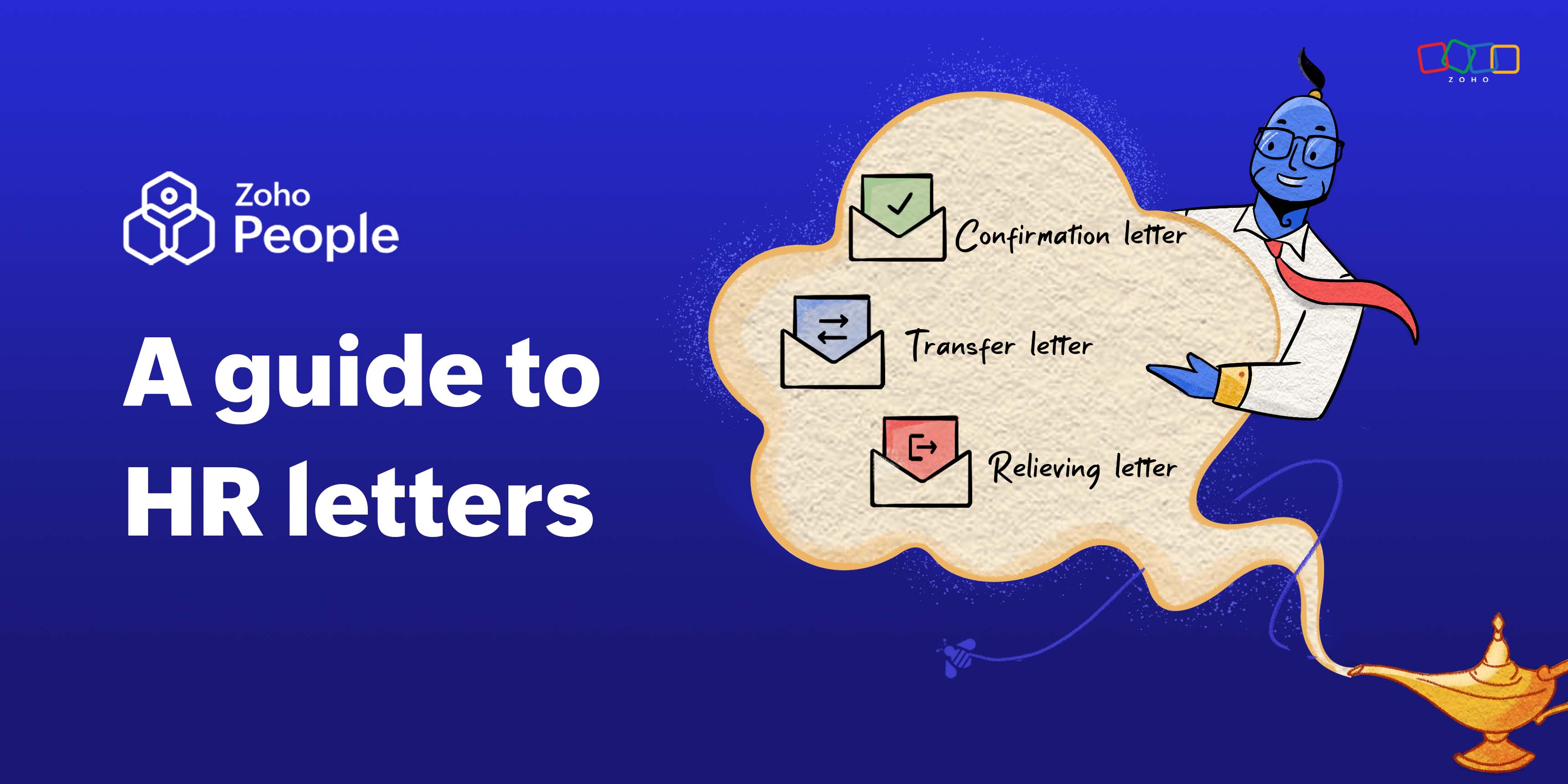- HOME
- HR insights
- 9 different types of HR letters
9 different types of HR letters
- Last Updated : September 16, 2025
- 2.5K Views
- 5 Min Read

HR letters play a crucial role in informing employees about work-related matters, from the time they're hired to the time they leave the organization. These letters have to be properly drafted and shared, since they convey important details about employment (like hours, pay, responsibilities, promotions, and transfers) and workplace policy. This information often serves as evidence for the agreement between employers and employees during audits or legal proceedings. That's why it's essential to draft these letters accurately—it improves transparency, facilitates proper communication, eliminates misunderstandings, and helps your company stay compliant. Let's dive into the different types of letters that HR teams have to manage throughout an employee's lifecycle.
Different types of HR letters

Proof of employment
Purpose: Proof of employment, as the name indicates, is an HR letter that is often provided upon an employee's request to confirm their association with their organization. It also confirms their date of joining, position, designation, and salary. Proof of employment is often required by employees to get their loans approved, apply for credit cards, verify their income, apply for visas and work permits, and complete rental agreements.
Key elements: Company name, company address, the contact information of the employer, the employee's full name, their employee ID, employment date, salary information, designation, authorized signature, name and designation of authorized signatory, company letterhead, and stamp.
Offer letter
Purpose: An offer letter is often provided to inform candidates that they've been offered a position with the company. It usually outlines the terms and conditions of their employment to set clear expectations and is documented carefully to ensure compliance.
Key elements: Company name, name of the new hire, date of joining, designation, employment type, start date, work location, salary information, list of benefits, probation period, expected working hours, termination clauses, and authorized signatory.
Confirmation letter
Purpose: A confirmation letter is often offered to employees once they complete their probation to let them know that they've secured a permanent position at their organization. It also indicates that the employee's performance during the probation period was satisfactory. If there's a new position or salary hike involved, that is mentioned too.
Key elements: Name of the employee, probation start and end date, employment confirmation statement, updated employment terms (if applicable), name of the organization, and authorized signatory.
Transfer letter
Purpose: A transfer letter, as the name indicates, is offered to employees who are transferred to a new location, role, or department within the organization. It sets clear expectations about the implications of the transfer and provides all the necessary details about their new location, role, or designation.
Key elements: Name of the employee, details about the new role, designation, or location, effective date, changes in employment terms (if applicable), and authorized signatory.
Probation extension letter
Purpose: A probation extension letter is issued to new hires to let them know that their probation period has been extended. This usually happens when the new hire fails to perform according to the expectations of their team. In such cases, they are given additional time to level up their performance and prove themselves as a valuable resource.
Key elements: Name of the new hire, reason for probation extension, extension duration, and authorized signatory.
Promotion letter
Purpose: A promotion letter is issued to employees to keep them informed about their promotion to a higher role.
Key elements: Name of the employee, new job title, promotion effective date, details about salary hike or bonus (if applicable), list of new responsibilities, changes to reporting structure (if applicable), appreciation for their hard work, and authorized signatory.
Salary increment letter
Purpose: A salary increment letter is issued to employees to keep them informed about their salary hikes. It is usually offered to provide clarity on the revised salary details and the effective date. It also typically appreciates them for their efforts.
Key elements: Name of the employee, current monthly CTC, revised monthly CTC, effective date, changes in terms and conditions (if applicable), appreciation message, and authorized signatory.
Experience letter
Purpose: An experience letter is offered to employees during the time of their resignation to confirm their tenure at their organization and highlight their roles and responsibilities. Employees often use these letters during job applications and other career transitions.
Key elements: Name of the employee and their contact information, joining date, ending date, list of responsibilities, and authorized signatory.
Relieving letter
Purpose: A relieving letter is a formal document that is issued to employees to acknowledge that their resignation has been approved. Employees may be required to submit this when moving on to a new opportunity.
Key elements: Name of the employee and their contact information, acceptance of resignation, details about the notice period, relieving date, and authorized signatory.
Best practices for writing HR letters
Here are some of the best practices to have in mind while drafting formal letters for your employees:
Understand the purpose
While drafting an HR letter, consider why the letter is being offered to employees in the first place. This will help you keep the letter relevant and include all the necessary information. If there are any legal obligations associated with the letter, take them into consideration too. Any errors in these letters can cause employee dissatisfaction, unnecessary confusion, and in some cases even legal challenges.
Keep it professional but human
It's always good to maintain a professional and respectful tone. Be sure to use positive wording and encouragement even when writing about more negative topics, such as in probation extension letters or policy violation letters. Use simple and straightforward sentences to convey the meaning so that it's understood easily. Always have the tone of your letter aligned with your company's overall values and ethics.
Keep the expectations clear
Setting clear expectations in HR letters is crucial to effectively communicating the main message. For instance, if it's an experience, relieving, or proof of employment letter, be sure to enter the relevant dates without any ambiguity. Similarly, if it's an offer or promotion letter, list the roles and responsibilities involved with clear descriptions. If it's something like an offer letter, list the next course of actions that employees may be expected to complete, like submitting documents.
Comply with company guidelines
While drafting HR letters, it's essential to familiarize yourself with your company policy to keep the letters accurate. For instance, while writing a relieving letter, you need to know the notice period that your organization follows to include the relieving date accurately. Be sure to have details about salary hikes, probation periods, employment terms, deadlines, roles, and responsibilities in line with your company rules.
How Zoho People simplifies HR letter management
Zoho People, our cloud-based HR software, comes with an all-inclusive document management system that's integrated with Zoho Sign, so it's super easy for HR teams to create, share, and get HR letters signed in just a few steps. Plus, these letters are drafted in a way that aligns with the legal mandates of your organization's region.
 Tarika
TarikaContent Specialist at Zoho People


